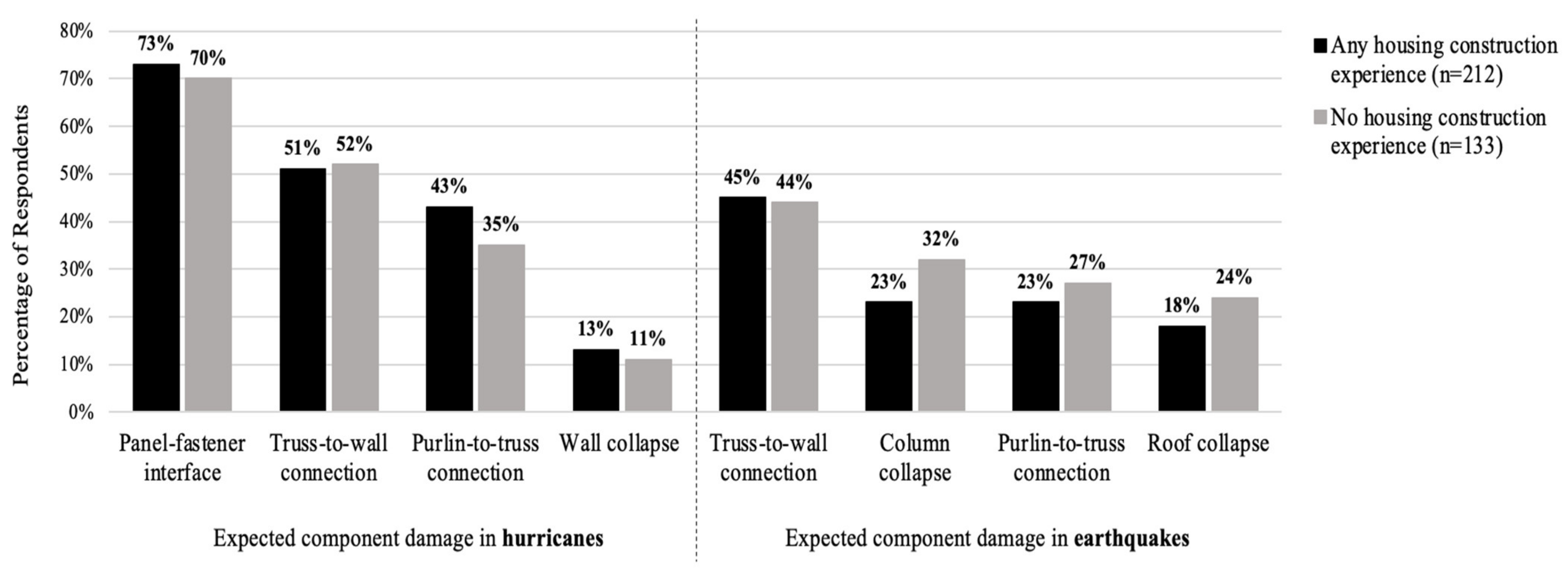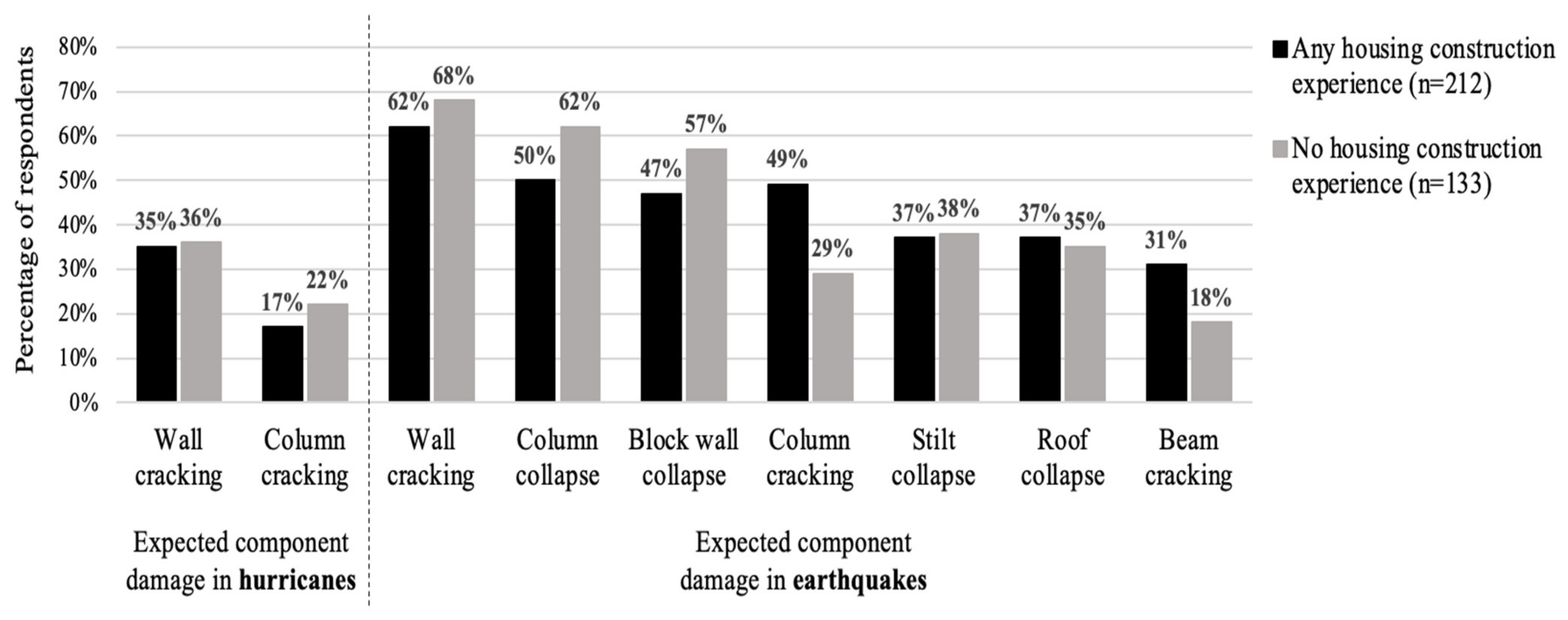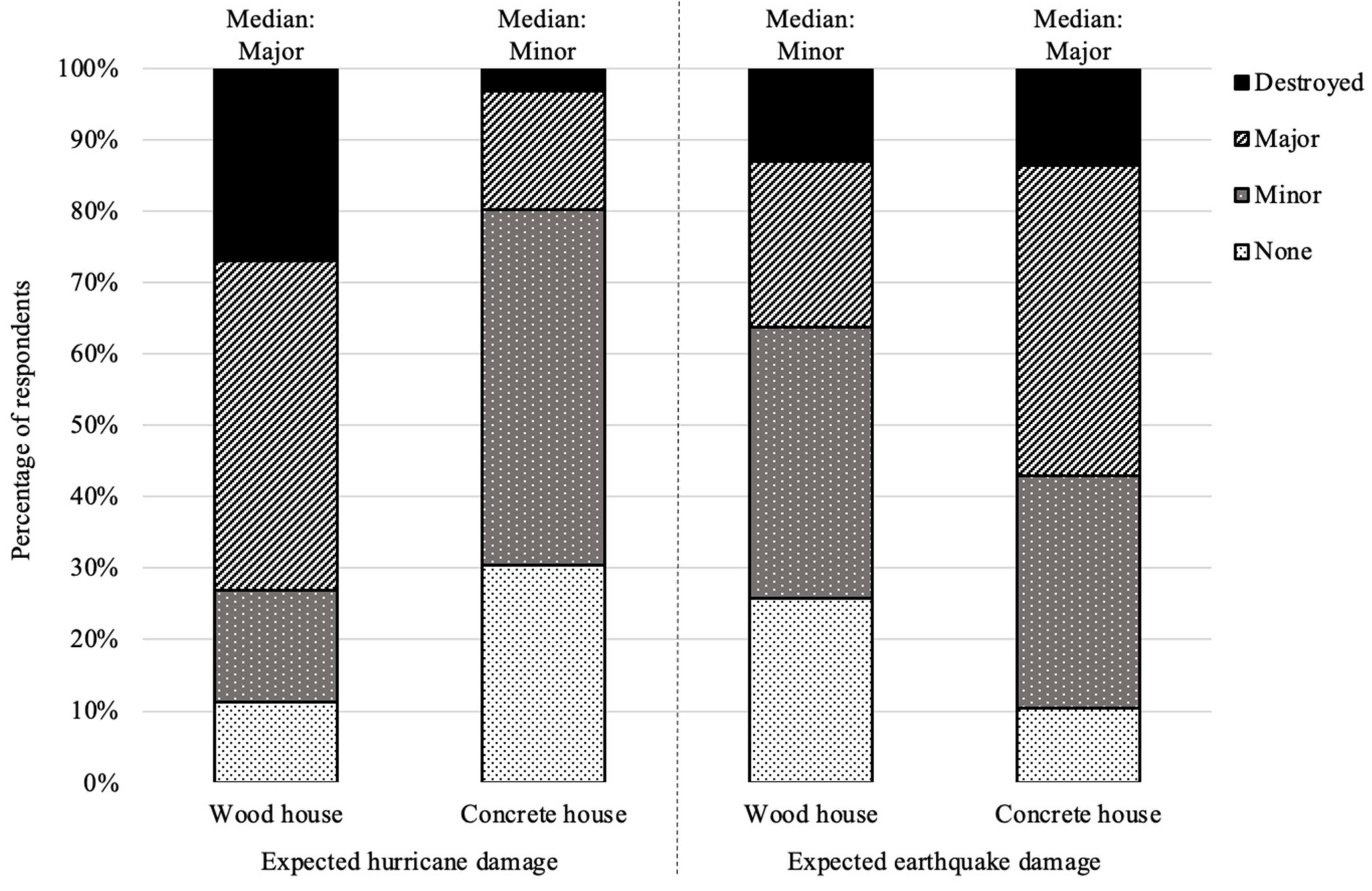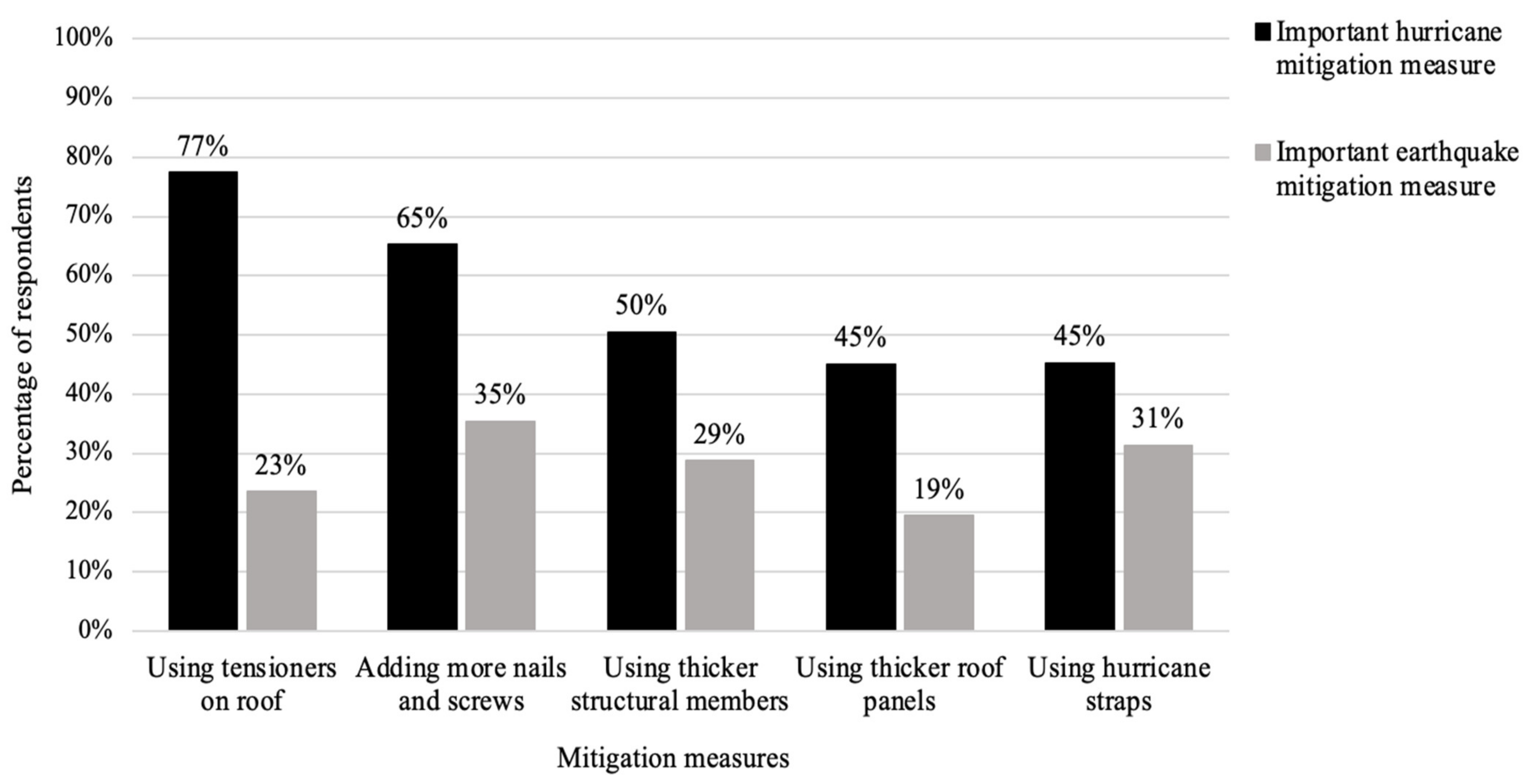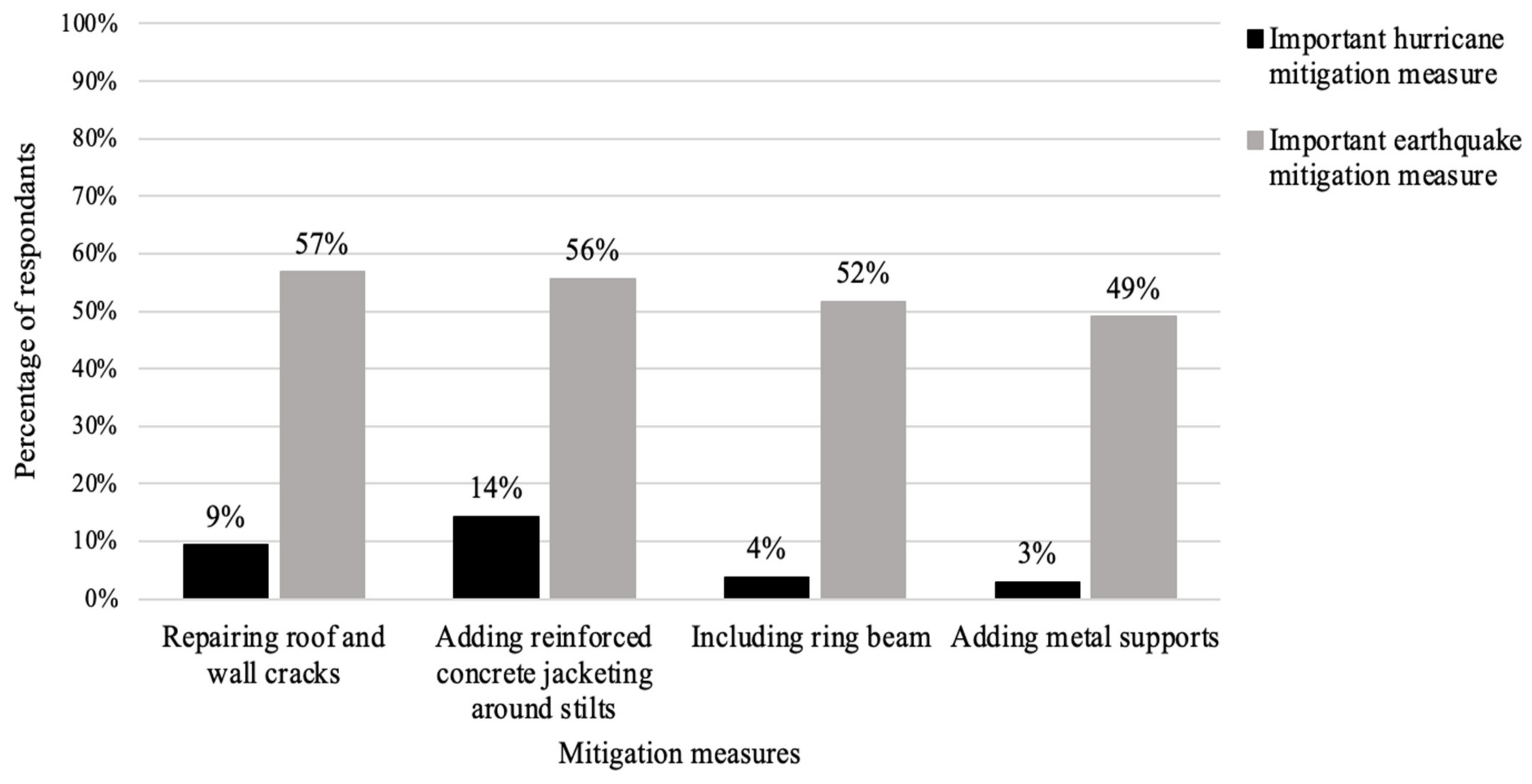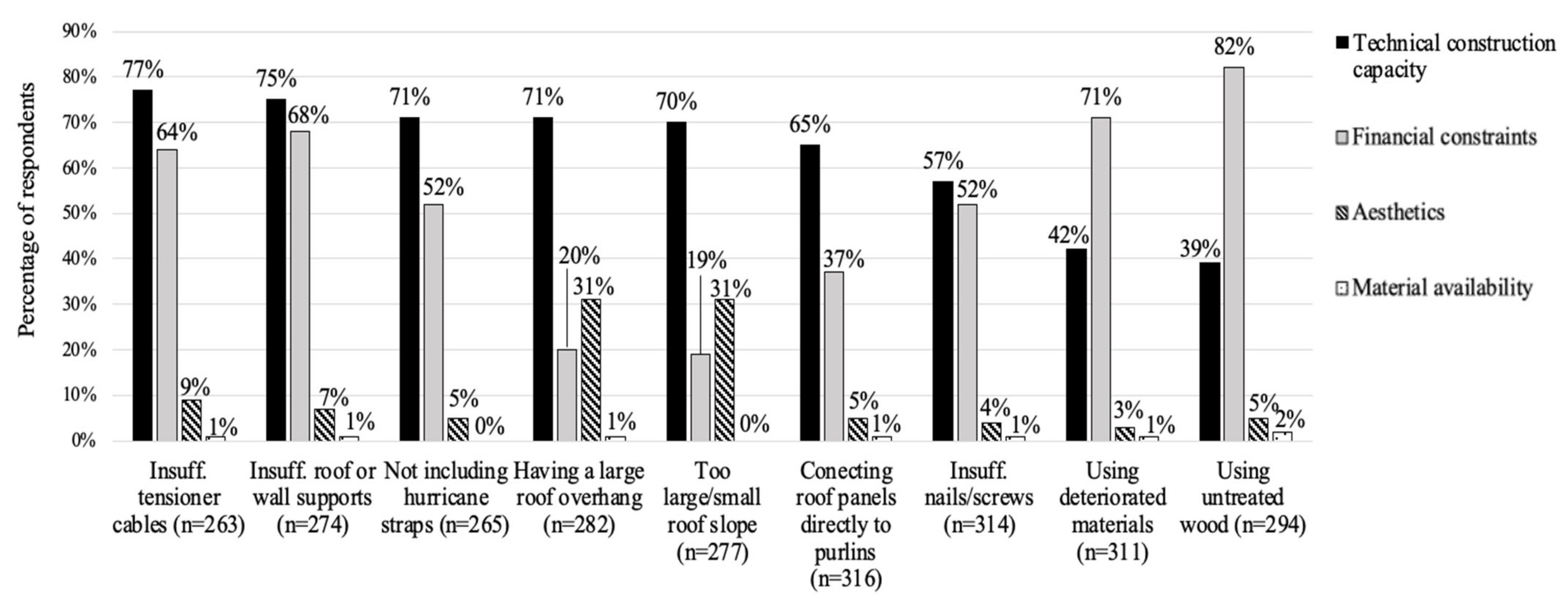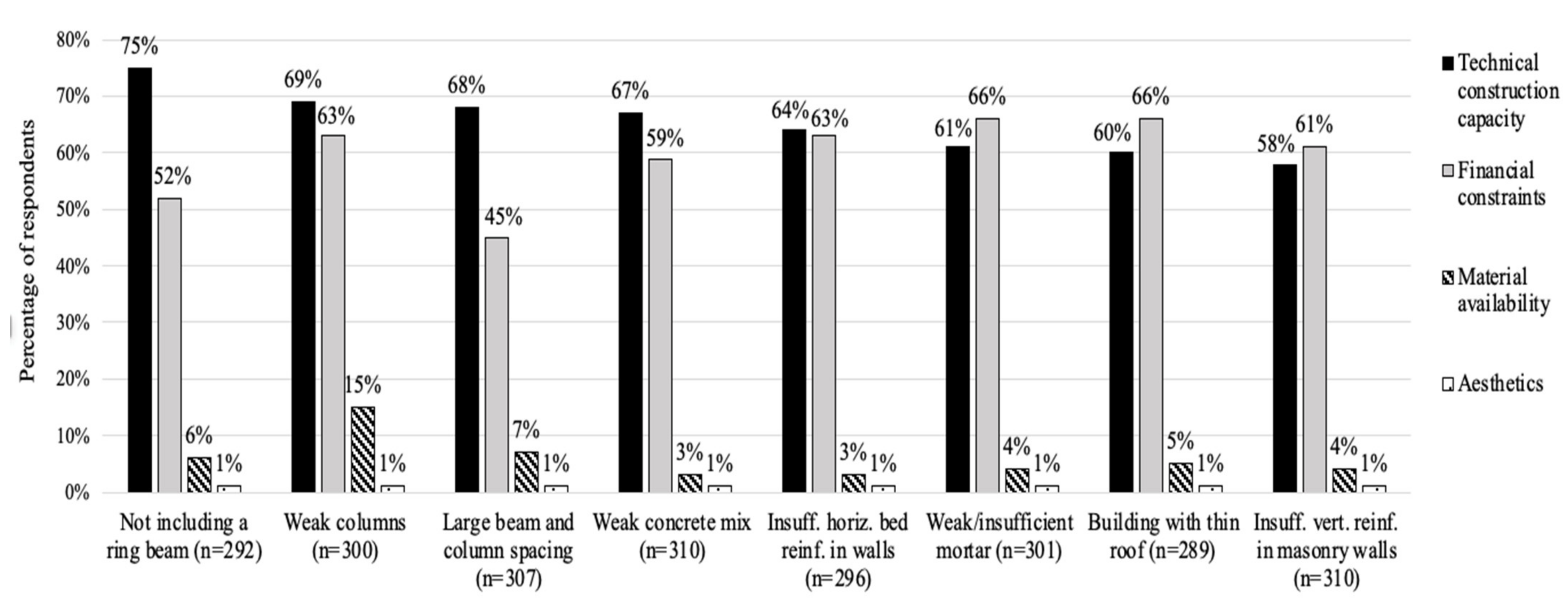1. Introduction
Disasters are growing in frequency and severity of impacts [
1] and destroying hundreds of thousands of houses each year worldwide [
2]. These disasters arise from complex yet predictable interactions between hazards, the built environment, and communities’ pre-existing societal, economic, and geographical vulnerabilities [
3]. The effects of disasters can be mitigated by addressing the symptoms of societal vulnerabilities that turn hazards to disasters. One such symptom is prevalent construction of unsafe infrastructure that may be damaged as the result of a hazard event [
4]. Socio-economic and socio-political vulnerabilities, such as resource inequalities, technical construction capacity, and weak regulatory enforcement or supervision of housing construction, lead builders or households themselves to inadvertently construct unsafe housing in hazard-prone regions.
Most of the world’s housing is constructed informally, whereby residents hire builders to construct housing that reflects their needs, available resources, and cultural values. This informally constructed housing varies widely across high- and low-income communities, from converted basements or garages to housing self-built in informal settlements [
5,
6]. These informal construction processes provide the only means of housing access for individuals who have low incomes, who cannot secure land tenure, or are otherwise unable or unwilling to engage formal housing construction processes [
7].
When building codes and other regulations are not consistently followed or enforced, the safety of housing depends largely on the construction material and design decisions made by builders and households. Local perceptions of housing safety, including feelings of fatalism and perceptions of efficacy of hazard mitigation measures [
8], dictate informal construction practices [
9]. The informal nature of this construction process leads to housing with a wide variation of the structural and architectural elements that determine housing safety [
10,
11,
12].
The safety and risk perceptions that affect housing are more complex in multi-hazard environments because, in these contexts, those making construction decisions must interpret the safety and risk of housing in the face of multiple hazard types that may affect structures in different ways, presenting difficult tradeoffs. One likely outcome of these tradeoffs may be design practices that respond to the more common hazard while failing to address other less frequent but potentially devastating hazards [
13,
14].
This study investigates how individuals involved in and familiar with informal housing construction are assessing, identifying, and attempting to mitigate hazard risks through the process of building housing. We address the research question: What are the local housing safety perceptions among those working and advising within the informal construction sector in a multi-hazard environment of Puerto Rico? Specifically, we study perceptions of expected damage, unsafe design and construction practices, and changes to construction practices. This study seeks to improve housing safety in the U.S. Caribbean island Puerto Rico in the face of seismic and hurricane hazards, where it is estimated that over half of all commercial and residential construction is completed informally [
15].
4. Methods
To investigate the housing safety perceptions of those most familiar with housing construction practices across Puerto Rico, this study statistically analyzes a survey administered to 345 builders and hardware store employees working in and advising on Puerto Rico’s informal construction sector.
4.1. Survey Design
We developed this survey following over 50 pilot interviews with Puerto Rican households, builders, hardware store employees, engineers, architects, and staff from community-based organizations across 12 of Puerto Rico’s 78 municipalities [
28]. We completed these pilot interviews to understand general perceptions of the safety of wood and concrete housing types and their structural components, including perceptions of expected damage, mitigation measure importance, and reasons for unsafe housing design and construction practices. Our experience with pilot interviews revealed the willingness of respondents to elaborate on the unsafe practices they see others engaging in within the informal construction sector rather than their own practices.
Once we reached saturation with these interviews, we developed a pilot survey. For each question in this pilot survey, we asked builders and hardware store employees to select items from existing multiple-choice questions or elaborate on what they thought was missing. In the pilot survey, we also asked respondents to explain “typical” housing in Puerto Rico. While respondents repeatedly told us that there was no typical house, they would freely discuss the unsafe construction practices they saw others commonly engaging in. Thus, we worked with local research assistants and builders to design a survey that encouraged respondents to describe informally constructed housing and then prompted them to discuss their opinions of the various design and construction practices. After completing 15 pilot surveys, we again reached saturation on answer options, no longer receiving new responses, and developed our final survey.
The final survey we developed seeks to uncover perceptions of safe and unsafe housing design and construction practices in the face of multiple hazards. Safe housing design and construction constitutes the use of building techniques or materials that lead to a structure that will resist hazards without structure failure or substantial losses [
4,
53]. Thus, our survey captures the ideas of housing safety by asking respondents about expected damage in the face of multiple hazards, unsafe design and construction practices, and important hazard mitigation measures. Recognizing that studies have found a relationship between prior hazard experience and perceived risk [
21,
23,
54] and hazard mitigation measures [
8,
55], we also included a series of questions to capture each respondent’s prior experience with disasters and housing damage. Survey questions in Spanish were written by local research assistants, with language carefully considered to ensure consistency with the local building professionals.
Table 1 includes an overview of survey questions by category; the full survey (in English) can be found in
Supplementary Information S1.
To capture respondents’ expected damage to housing types and components in multiple hazards, the survey asked respondents to describe the expected damage to two main housing types: wood-frame, hereby referred to as “wood”, and reinforced concrete/masonry, referred to as “concrete”. The survey prompted respondents to rate the expected damage in a hurricane with the strength of Hurricane Maria and an earthquake with the magnitude of the 7 January 2020 earthquake. Each of these disaster scenarios is recent and familiar to the respondents. For expected damage, the rating scale offered the options of “No damage”, “Minor damage”, “Major damage”, and “Destroyed”. We provided examples to explain the meaning of “minor” and “major” damage based on existing literature [
56,
57]. Once individuals indicated the damage level they expected for each housing type and hazard, we prompted them to select each housing component or system they would expect to be damaged. The components provided as options, such as metal roof panels, were based on field observations, reconnaissance reports from Hurricane Maria and the 2019–2020 earthquakes [
47,
58], and pilot interview and survey responses.
Next, we asked respondents about the wood and concrete housing construction practices they perceive as unsafe in hurricanes and earthquakes. Then, once respondents listed each of the unsafe design and construction practices they saw as prevalent, they were prompted to expand on the reason why they perceive others are making these errors, including the options: financial constraints, or “lack of financial resources”; technical construction capacity, or “lack of construction knowledge”; aesthetics, or “to make it look better”; and material constraints, or “lack of material availability”. We based these options on emerging themes in pilot interviews and surveys.
Finally, the survey asked respondents about their perceived importance of mitigation measures to improve housing safety for each hazard and building type. With this information, we captured perceived efficacy of different design and construction practices, which previous studies have linked to willingness to adopt mitigation measures [
8].
4.2. Survey Administration
This study relied on the assistance and expertise of eight local research assistants in developing and disseminating this survey in Spanish. The survey was administered using both online survey software and in-person surveys, depending on preference and the evolving circumstance of the COVID-19 pandemic, from June 2020 to August 2021.
The study’s target population, builders and hardware store employees, has not been systematically estimated and is likely relatively small. Our study includes individuals working in this population across Puerto Rico but excludes the smaller Puerto Rican islands of Vieques and Culebra due to the COVID-19 pandemic. Housing tended to vary by income level and local hazard experience but without significant geographic trends. Therefore, this study focused on obtaining surveys from a distribution of communities across the estimated path of Hurricane Maria and distances from the epicenter of the 2019–20 earthquakes to investigate any potential variation in perceptions and construction practices due to prior hazard exposure.
We incentivized surveys with $10 USD gift cards upon successful survey completion and completed all survey recruitment and administration following IRB protocol #19-0337. After fifteen months of survey administration, the team of research assistants reported that they had exhausted the available and willing builders and hardware store employees and we concluded data collection.
4.3. Statistical Analysis
We asked each respondent to list their municipality rather than specific neighborhood in the survey. Thus, we quantified distances from Hurricane Maria’s path on the approximate distance (in 5-m increments) between the storm’s path [
59] and the most populated city center in each municipality. This distance was an estimate, ranging from roughly 5 m in Caguas, which the storm passed over, to over 30 miles near Guánica. To calculate the distance between each municipality and the earthquake’s epicenter, we compared the epicenter’s geographical coordinates [
60] to that of the most populated city center in each municipality. Finally, to evaluate whether prior housing construction experience influenced individual’s responses throughout the survey, we created a variable to indicate whether respondents had indicated “any” or “no” construction experience when asked about the types of housing construction they had previously participated in.
We characterized general trends using descriptive, correlation, and logistic statistical tests to analyze the survey data. Initial descriptive statistics allowed us to demonstrate the demographics, prior hazard and construction experience, expected damage, and other housing safety perceptions of a so far understudied group. We evaluated the relationship between and effects of respondent characteristics on perceptions of the safety of informally constructed housing in multiple hazards with Chi-square statistics, which compares categorical variables to determine whether they are different from each other [
61]. We used Kruskal–Wallis rank sum [
62] tests to determine whether there were statistically significant relationships between respondents’ prior hazard exposure and expected damage in future hazards because this test allowed us to investigate non-parametric relationships between a continuous independent variable and ordinal dependent variable. We used binomial logistic regression [
63] to evaluate relationships between categorical variables, including between prior hazard and construction experience and perceptions of expected hazard damage. We evaluated statistical significance with a
p-value of 0.05 (95% confidence). For more information on supporting statistical analyses discussed within this study, the
Supplementary Information S2 includes the statistical results.
5. Results and Discussion
Our results first report respondent demographics and prior experience. Then, we examine respondents’ perceived housing damage in each hazard, the relationship between prior hazard and construction experience on housing safety perceptions, perceived efficacy of hazard mitigation measures, and perceived barriers to safe informal housing construction.
5.1. Respondent Descriptive Statistics
In total, the survey had 345 respondents.
Table 2 provides the descriptive statistics for respondents.
All of the contractors, 46% of the hardware store employees, and 73% of those with other job titles reported having any prior housing construction experience. Respondents had between 3 and 60 years of experience in housing construction or working in hardware stores.
When reporting the type of prior construction experience, 108 (31%) respondents reported general housing construction experience, 28 (8%) reported working on an expansion or addition to a house, 92 (27%) reported working on a remodel of a house, 75 (22%) stated they had worked on housing repair or reconstruction after a hurricane, and 29 (8%) reported working on housing repair or reconstruction after an earthquake. Further, when asked about the type of house on which respondents worked, 64 (19%) noted experience working on wood houses, 130 (38%) reported experience with concrete houses, 20 (6%) stated they had worked on concrete houses with wood roofs, and 23 (7%) reported working on a house with a concrete first story and wood second story. Thus, the respondent group has both broad and deep expertise in the housing of interest.
Respondents also had varied experience with hurricanes and earthquakes. While Hurricane Maria led to damage and destruction across the entirety of Puerto Rico, the hurricane made groundfall near the southeastern municipality of Yabucoa and then passed northwest through the island. Compared to the roughly 30-mile (48 km) width of Hurricane Maria’s winds, Puerto Rico is a relatively small island at 35 miles (56 km) wide and 100 miles (161 km) long. When completing the survey, respondents lived between zero and 40 miles (64 km) from the storm’s central path, with the mean distance of 14.5 miles (23 km) from this path. The 2019–2020 earthquakes occurred in the southwest and led to substantial damage across urban regions of Guánica, Ponce, and neighboring municipalities. Respondents lived between 8.6 miles (14 km) and 81 miles (130 km) from the 7 January 2021 earthquake’s epicenter, with a mean of 69.4 miles (112 km).
The survey also asked respondents to rank the level of damage they personally experienced in their home in Hurricane Maria and the 2019–2020 earthquakes. When asked about housing damage from Hurricane Maria, 12 (3%) respondents indicated their housing was destroyed, 89 (26%) said their houses were majorly damaged, 121 (35%) reported minor damage, and 123 (36%) said their houses did not have any damage. In the 2019–20 earthquakes, one respondent stated their house was destroyed, 3 (1%) said their housing was majorly damaged, 125 (36%) indicated minor damage, and 216 (63%) indicated no damage. Generally, respondents experienced more severe damage in Hurricane Maria than the 2019–2020 earthquakes, with 29% of respondents indicating their house had major damage or was destroyed in Hurricane Maria. Only four respondents (1%) reported these damage levels in the earthquakes.
5.2. Prior Hazard Experience Did Not Influence Expected Level of Housing Damage
While we hypothesized that prior hazard experience would influence expected level of housing damage (Hypothesis 1), our results did not find statistically significant relationships to support this hypothesis. To capture prior hazard experience, we investigated respondents’ prior hurricane and earthquake housing damage as well as location with respect to these hazards. We found no statistically significant relationship between respondent distance from Hurricane Maria’s approximate central path and expected level of hurricane damage to wood (not significant, p = 0.80) or concrete (not significant, p = 0.26) housing. There was also no significant relationship between distance from the 2019–2020 earthquakes’ epicenter and expected earthquake damage to wood (not significant, p = 0.50) and concrete (not significant, p = 0.26) housing.
Overall, while other studies have shown relationships between prior hazard experience and risk perceptions [
20,
21,
24], our study does not come to these same conclusions. We suggest that this observed difference is due to context. In particular, the small size of Puerto Rico, which resulted in shared experience of Hurricane Maria, and the widespread media coverage and fear of the damage from the 2019–2020 earthquakes, has resulted in similar hazard experience regardless of location. Our findings align with that of other studies which did not find significant differences in hurricane risk perceptions based on distance from the coast if all communities were located within a relatively hazardous coastal region [
22,
24].
5.3. Construction Experience Influenced Perspectives of Structural Systems
Confirming our hypothesis (Hypothesis 2), prior construction experience influenced housing safety perceptions. Across all combinations of housing and hazard types, the data suggest that respondents with prior housing construction experience had a more nuanced perspective of structural systems. Individuals with construction experience were more likely to anticipate how failures of specific components in a house would affect other components or subsystems, potentially leading to more catastrophic failures. Those with construction experience were also less likely than those without to have fatalist perspectives of housing component failures.
5.3.1. Perceptions of Wood Housing Safety
For wood houses, we asked respondents about failure at the panel-fastener interface (i.e., panels being ripped off), failure at the purlin-to-truss connection (i.e., some of the wood roof structure being ripped off with panels), failure at the truss-to-wall connection (i.e., roof being torn from walls), wall failure (i.e., racking), and roof collapse.
Figure 1 shows the percentage of respondents who indicated expected damage to each wood housing component, sorted by whether a respondent had prior housing construction experience. We based each percentage on the total count of respondents with any (
n = 212) or no (
n = 133) construction experience.
Most respondents identified panel failure due to fastener tear out as the expected damage. While half of the respondents expected damage to the truss-to-wall connections, less than half expected damage to the purlin-to-truss connections. Only 12% of respondents expected wall collapse in a hurricane. For wood houses in an earthquake like that of 7 January 2020, slightly under half of the respondents expected damage to the truss-to-wall connection, while fewer respondents listed column collapse, purlin-to-truss connection failure, and roof collapse.
When considering the specific components respondents expected to fail in wood housing in a future hurricane like Hurricane Maria, observable (yet not statistically significant,
X2 (
N = 345) = 2.95,
p = 0.57,
McFadden R2 = 0.01) trends suggested respondents with any housing construction experience were more likely to expect damage to the purlin-to-truss connection. These findings reveal that those with housing construction experience had a systems perspective of wood housing, understanding the purlin-to-truss connection is a structural system influenced by the failure of other components such as the panels and purlin-to-truss connection. The respondents without any housing construction experience have likely seen visible examples of panel and wall failures, while purlin-to-truss connection failure is a less visible failure mode. Venable et al. [
24] had similar findings, revealing that residents, who mostly did not have housing construction experience, did not think of housing safety with a systems perspective. This was evidenced by respondents not expecting failure to their house’s walls to lead to roof failure in a future typhoon [
24]. This lack of systems-thinking can lead to individuals strengthening specific housing components, such as their roof-to-wall connection, without considering how they could be influencing or protecting against other, more catastrophic housing failures.
5.3.2. Perceptions of Concrete Housing Safety
Next,
Figure 2 shows the percentage of respondents who indicated expected damage to each concrete housing component, sorted by whether a respondent had prior housing construction experience, with percentages based on the total number of respondents with any or no construction experience.
Overall, many respondents expected wall cracks as well as more catastrophic failures such as column and block wall collapse in an earthquake like that of 7 January 2020. Respondents with construction experience were more likely to list beam and column cracking as expected earthquake damage than those without experience,
X2 (
N = 345) = 20.7,
p < 0.005,
McFadden R2 = 0.04. In contrast, respondents without construction experience were more likely to list more catastrophic or fatalistic expected damage such as column collapse,
X2 (
N = 345) = 20.7,
p < 0.005,
McFadden R2 = 0.04. Other studies have shown that increased education about and experience with earthquakes [
26] reduces fatalist perceptions of that hazard type. Our results build from these findings, revealing that those with housing construction experience have more nuanced understanding and less fatalistic perspectives about housing safety in earthquakes.
5.4. Respondents View Concrete Housing as Safer in Hurricanes and Wood Housing as Safer in Earthquakes
Our results confirm our hypothesis (Hypothesis 3) that respondents generally expect greater damage to wood housing in a hurricane and concrete housing in an earthquake. We found this by investigating respondents’ expected damage to wood and concrete housing in a hurricane with wind speeds similar to Hurricane Maria and an earthquake similar to the one that occurred on 7 January 2020, with results shown in
Figure 3.
Respondents were more likely to expect greater damage to a wood house than a concrete house in a future hurricane, with
X2 (9,
N = 345) = 72,
p < 0.001. Conversely, respondents were more likely to expect damage to a concrete house than a wood house in an earthquake, with
X2 (9,
N = 345) = 70,
p < 0.001. Our findings align with previous studies in the Caribbean, showing that contractors and homeowners prefer heavier reinforced concrete and masonry housing to withstand hurricanes [
13,
14,
28,
50]. In Puerto Rico, Goldwyn et al. [
28] also noted examples of contractors and homeowners explaining that wood housing is safer in earthquakes but still opting for concrete construction because hurricanes are more common.
While there was a notable difference in the percentage of respondents who expected wood housing to be destroyed in a hurricane versus concrete housing (27 and 3%, respectively), similar percentages of respondents indicated that both wood and concrete housing (13 and 14%, respectively) would be destroyed in an earthquake. Thus, while respondents generally expect more damage to concrete housing in earthquakes, they still have a fatalist perspective of either housing type in a strong earthquake. This fatalism is likely motivated by less generational earthquake experience. Other studies have demonstrated that contractors and residents are often unaware of the low cost of adequate seismic detailing required for seismic safety [
64].
5.5. Respondents Doubted the Efficacy of Hazard Mitigation Measures for Earthquakes
Our results supported our hypothesis that respondents would doubt the efficacy of hazard mitigation measures more for earthquakes than for hurricanes (Hypothesis 4). To capture this perceived efficacy of hazard mitigation measures, we asked respondents about which changes to design and construction practices they perceived as important to increase wood and concrete housing safety. For wood houses, the survey asked about hurricane straps, using thicker metal roof panels, using stronger or larger structural roof members, tying down the roof with tensioner cables, and replacing nails with screws.
Figure 4 and
Figure 5 show respondent perceptions of which changes to construction practices are important to increase safety for wood and concrete housing, respectively. While 95% of the respondents selected at least one hurricane mitigation measure as important, only 70% of respondents selected any of the seismic mitigation measures as important to increase housing safety. However, going slightly against what we initially hypothesized, respondents still demonstrated uncertainty about the efficacy of the hurricane mitigation measures
Despite prior engineering assessments of Puerto Rican informally constructed wood housing recommending using thicker structural members, thicker roof panels, and hurricane straps [
11], 50% or less of respondents indicated each of these measures were important. For wood housing, respondents were more likely to list changes as important for hurricane safety than earthquake safety, which is consistent with the visible housing damage after Hurricane Maria. In total, 95% of all respondents indicated at least one change as important to increase housing safety in hurricanes. Respondents generally indicated changes to prevent panel-fastener failure were the most important hurricane mitigation measures, with 77 and 65% of respondents indicating tensioners and thicker roof panels were important, respectively.
Respondents were more likely to list changes to concrete housing as important for earthquakes than for hurricanes. This is no surprise given the visible damage to concrete houses in the 2019–2020 earthquakes and the fact that engineers and researchers studying seismic safety in this context have recommended each of these listed mitigation measures (i.e., [
12,
47]).
Despite 90% of respondents indicating that concrete housing would be damaged in a future earthquake like that of 7 January 2020, respondents did not appear to have a clear understanding of the mitigation measures they as individuals can implement to increase their housing safety in future earthquakes. A total of 30% of the respondents did not indicate that any of the listed seismic mitigation measures were important, with the other 70% of respondents spread across each of the potential changes. Respondents also did not suggest other methods of increasing concrete housing safety in the question’s open-ended “other” response option. Indeed, the highest percentage of respondents indicated repairing roof and wall cracks as important (57%), but this is not a commonly suggested seismic mitigation measure other than ensuring the structure is protected from water intrusion and subsequent reinforcement corrosion (e.g., [
65]). Instead, reconnaissance reports after the 2019–2020 earthquakes noted that the main structural vulnerabilities that contributed to widespread damage were soft stories without strong supporting columns, or “stilts”, and weak masonry walls [
47]. These structural vulnerabilities could be mitigated through the inclusion of a ring beam in initial design or by retrofitting with reinforced concrete jacketing around the “stilts” or columns supporting the soft story structure [
12,
66]. Homeowners in Puerto Rico also used metal supports under their soft story structures as an immediate retrofit option during the aftershocks. Thus, the fact that less than 60% of the respondents indicated that any of these mitigation measures is important alludes to widespread uncertainty about seismic mitigation.
In addition to less experience and more uncertainty with concrete housing safety in earthquakes, construction practices that influence earthquake safety of reinforced concrete/masonry housing are much less visible [
33] and depend on the hidden design details of the concrete mix, reinforcement, blocks, and mortar. The infrequency of earthquakes means that contractors and homeowners across Puerto Rico likely have not seen much evidence of the construction practices that did and did not prove to be safe in the earthquakes [
19,
67]. In contrast, when respondents saw evidence of the types of houses that withstood Hurricane Maria, they understood which changes were important to increase housing safety. Likewise, when we asked respondents about expected damage to housing in an earthquake like that of 7 January 2020, they generally expected more damage to reinforced concrete/masonry than wood housing but with similar percentages of respondents expecting each housing type to be destroyed. This shows respondents’ uncertainty about the safety of either housing type in earthquakes. Respondents feel confident that concrete housing can withstand future hurricanes but feel less sure about the safety of both wood and concrete housing in earthquakes. Respondents likely have a fatalistic expectation of housing destruction in earthquakes as they are a less frequent and thus less understood hazard, as indicated by the relatively large fraction of respondents who indicated housing would be destroyed.
5.6. Unsafe Construction Practices Are Driven by Technical Construction Capacity
Our findings do not support our hypothesis (Hypothesis 5), revealing instead that technical construction capacity is the primary reason for many unsafe housing construction practices rather than financial constraints.
The survey asked respondents to list the reasons they believe builders are engaging in practices the respondents believed were unsafe, including financial constraints, technical capacity constraints, aesthetic preferences, or material availability.
Figure 6 and
Figure 7 show respondent’s perceptions of why people are engaging in unsafe construction practices, first looking at wood and then concrete housing design and construction practices.
Although researchers have documented evidence of financial constraints being the primary influence of whether or not individuals mitigate the negative impacts of hazards [
8,
34], our findings suggest that more respondents consider technical capacity constraints than material and financial constraints as reasons for these unsafe construction practices. According to the survey respondents, technical construction capacity is a prevailing reason for most unsafe housing construction practices. The largest percentage of respondents selected construction capacity for seven of the nine unsafe wood housing construction practices and five of the eight unsafe concrete housing construction practices.
For wood houses, nearly three quarters of respondents indicated that these construction capacity constraints were a reason for not building with hurricane straps, having a roof slope that is too high or low, not having sufficient roof or wall supports, and connecting metal roof panels directly to purlins without a plywood layer between. A total of 57% of respondents also indicated that using insufficient nails and screws was due to technical construction capacity, but financial constraints were also mentioned by 52% of respondents. In particular, financial constraints were primary reasons for construction practices that pertained to material quality of wood housing specifically, including using deteriorated materials and untreated wood. For concrete houses, respondents were more likely to list financial constraints as reasons for insufficient mortar, horizontal reinforcement, vertical reinforcement, and roof thickness in concrete housing. Respondents perceived that all other unsafe construction practices for concrete as primarily due to lack of technical construction capacity.
Limited respondents indicated material availability or aesthetics as reasons for unsafe construction practices for either housing type. Less than 2% of respondents listed material availability as a reason for unsafe wood construction practices, indicating that wood housing material availability, including hurricane straps, is not a challenge. A total of 15% of respondents indicated that builders were constructing weak columns based on material availability, while less than 7% listed material availability as a reason for any of the other practices. These results also reveal aesthetic preferences are likely not a significant contributor to unsafe construction practices of wood but not concrete houses. Even with wood houses, though, this was not the major reason given for any of the unsafe practices, with 31% stating this was a reason for having a large roof overhang and too large or small of a roof slope and 17% of respondents providing this reason for not including hurricane straps.
5.7. Respondents Believe Existing Sources of Construction Information Are Insufficient
Our results reveal that respondents generally believe builders go to hardware stores and friends or family for advice rather than engineers or contractors. This aligns with our hypothesis (Hypothesis 6) and gives more insight into the reasons for unsafe housing construction.
Our survey prompted respondents to indicate information sources that they believe households and builders most often rely on for information on safe housing construction and to which sources they believe individuals should go to for this information. Overall, out of the 337 respondents who answered this question, 213 (63%) selected hardware stores; 167 (50%) chose friends or family; 107 (32%) indicated social media, such as Facebook and YouTube; 98 (29%) chose municipal government offices, without any apparent trends based on geographical distribution; 62 (18%) listed community-based organizations; 42 (12%) listed contractors; and 25 (7%) listed engineers or architects. Overall, 160 (67% of the hardware store employees) hardware store employees listed hardware stores as a common information source for information on safe housing construction, indicating they have likely been asked about housing construction in the past.
More respondents listed hardware stores, friends or family, and social media as common sources of information on housing construction than municipal government offices, community-based organizations, contractors, or engineers and architects, likely contributing to the technical construction capacity constraints mentioned by respondents. These findings align with other studies showing the prominence of informal help systems of friends and family in Puerto Rico [
28,
32]. The results also support our survey population of builders and hardware store employees, showing their role as informal sources of design and construction information.
In terms of the question about which other sources respondents believe people should go to for information on safe housing construction, out of the 219 respondents who answered this question, 62 (28%) stated the municipal governments would, in theory, be a good information source. However, several elaborated that there are no existing services for this at any level, with one respondent explaining in the open-ended answer section, “I think there should be an agency that guides with all safe construction standards but I don’t know if there is such an agency.” A total of 91 (42%) of these respondents indicated that people looking for this construction information should go to engineers or architects, while 62 (28%) said they should go to contractors, 29 (24%) said they should go to hardware stores, 21 (10%) said they should learn through a vocational school, 8 (4%) stated that they should go to social media pages, and only 3 (<1%) said they should go to community-based organizations. Respondents largely indicated that people seeking information on safe housing construction should be going to municipal governments, engineers and architects, or contractors. Although over half of the respondents indicated hardware stores and friends or family members as the information sources most people currently go to for construction information, very few respondents said that people looking for construction information should go to these groups for construction information.
6. Limitations
This study reveals important and new insight into the multi-hazard housing safety perceptions of builders and hardware store employees frequently completing and advising on housing construction across Puerto Rico. However, as with any study, there are limitations. For one, the total population of individuals who build housing informally and work in hardware stores across Puerto Rico has yet to be estimated. So, we were unable to calculate a minimum required sample. Instead, we focused on capturing as many surveys as possible from every hardware store employee or builder willing to complete the survey over 15 months.
In addition, while we sought to capture both builders and hardware store employees’ housing safety perceptions with this survey, more of the survey respondents were hardware store employees than contractors. While builders readily contributed their thoughts during in-person interviews and surveys prior to the COVID-19 pandemic, after the pandemic builders had increased hesitancy to participate in the study, either due to the increased interaction with others or physical documentation of their activities. Puerto Rico also had strict pandemic restrictions during much of 2020, with individuals often needing proof of work when stopped in transit by police during stay-at-home orders. Thus, informal housing construction processes slowed.
Due to changes to survey administration practices to adapt to the evolving COVID-19 pandemic, the survey responses are not proportionally distributed across the island. The builders we were able to contact mostly lived in the northern and western regions, based on convenience sampling from research assistants’ networks; most builders noted they have worked across the entirety of the island.
7. Conclusions
The safety of informally constructed housing ultimately depends on the housing safety perceptions of those completing or advising on the design and construction decisions. To understand these perceptions, we surveyed 345 individuals informally completing and advising on housing design and construction with varying prior hazard exposure and construction experience in Puerto Rico, where most housing is built through informal processes. We investigated their perceptions of expected damage to wood and concrete housing in hurricanes and earthquakes, unsafe construction practices, mitigation measures, and the barriers to safe housing construction.
We found that prior hazard experience does not influence housing safety perceptions, while prior construction experience does. Respondents also generally expected more damage to wood housing in hurricanes and concrete housing in earthquakes, which has historically led them to build with concrete construction to withstand the more frequent hurricanes. Respondents demonstrated doubt in the efficacy of changes to design and construction practices to increase concrete housing safety in future earthquakes. This suggests that housing in earthquakes is less understood than either housing type in more frequent hurricanes. Respondents also appeared to have less general understanding of the ways that concrete houses can be designed to be safer in future earthquakes. The results also reveal that fatalist views and a lack of prior hazard experience with earthquakes are leading to uncertainty of how to best mitigate seismic damage.
Notably, we also found that more respondents believed technical construction capacity constraints, rather than financial or material constraints, were the primary reasons for many of the common construction practices they view as unsafe. Respondents also indicated that these technical construction capacity constraints are likely rooted in individuals primarily going to hardware stores or close friends and family members for information on safe housing construction rather than the government, engineers, contractors, or community-based organizations. The results also showed that those advising on construction without housing construction experience may also lack a systems perspective of housing safety and failure, which could lead to problems when structural components fail, interact with one another, and cause more catastrophic failures or structural collapse.
Future research could further inform disaster risk reduction in the informal construction sector by investigating methods of supporting technical construction capacity development, particularly focusing on systems perspectives of failure for those with less housing construction experience and the efficacy of different seismic mitigation measures to limit fatalist perspectives. Studies could also further inform disaster risk reduction in the informal construction sector by investigating informal construction information sources, including trust and the information shared by different sources.
